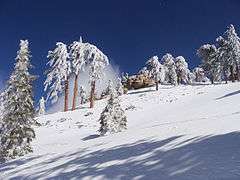Snow Valley Mountain Resort
| Snow Valley Mountain Resort | |
|---|---|
 | |
| Location |
Running Springs San Bernardino County, California |
| Nearest city | Running Springs, California |
| Coordinates | 34°13′24″N 117°02′15″W / 34.223375°N 117.037423°WCoordinates: 34°13′24″N 117°02′15″W / 34.223375°N 117.037423°W |
| Vertical | 1,041 ft (317 m) |
| Top elevation | 7,841 ft (2,390 m) |
| Base elevation | 6,800 ft (2,100 m) |
| Skiable area | 240 acres (97 ha) |
| Runs |
29 total |
| Lift system | 13 lifts: 1 Six Person High Speed Detachable, 6 Double, 5 Triple, 1 conveyor |
| Lift capacity | Six Person Detachable - 2,600 riders per hour |
| Terrain parks | The Edge, East Bowl |
| Snowfall | 150 inches (380 cm)[2] |
| Night skiing | Yes |
| Website | www.snow-valley.com/ |
Snow Valley Mountain Resort is a ski resort located in Running Springs, California, United States. It is the oldest continually operating ski resort in Southern California and is also one of four ski resorts in the San Bernardino National Forest.
Originally named "Fish Camp" for the pond located in the area, the site was developed into a roadside resort and lumber mill in the 1920s by the Swetkowich brothers. In the 1930s the slopes were developed for tobogganing and skiing by the Arrowhead Springs Corporation, which named the development Snow Valley.[3] The resort featured one of the first overhead cable ski lifts.[4] In 1940 the resort was purchased by Norwegian-American ski jump champion Johnny Elvrum, who expanded it.[3]
In 1974 W.R. Sauey became the owner of Snow Valley. His company the Nordic Group owns and operates Snow Valley. [5]
The resort operates under Special Use Permit from the United States Forest Service.[6]
Lifts
Snow Valley Mountain Resort has a total of 13 functioning lifts as of the 2017-18 season. The beginner lift, lift 6, is 1,197 feet long and is a double chair lift. It leads to the easiest run in the resort, thunder mountain. A lift that is still a beginner's lift but a little more challenging is lift 13. This lift is 1,235 feet long and leads to three runs: coyote flats (natural snow only), eagle flats (also known as the Rim Progression Park), and the hardest run, Graduation.
The previous main lift of the resort is lift 1, which is 4,701 feet long. It has a mid station that is right next to a restaurant called "Dear Meadow Grille". When at the top, it leads to moderate, advanced, and expert runs. When lift 1 is busy, another lift that goes a little lower than lift 1 is called lift 2. It goes 3,688 feet, and unloads skiers at a little hill called Race Peak. From here, there is one intermediate run, and 4 advanced runs. Most of these advanced runs are closed at the beginning and end of the season due to a lack of natural snow. Other than lifts 1 and 2, lift 3 serves as a lift which is on the other side of the mid station for lift 1.
New for the 2017 season is the 'Snow Valley Express', Southern California's First High-Speed Detachable 6 Seat Lift. The new chairlift will traverse more than three-quarters of a mile, approximately 4,636 feet up the mountain slope. Along the way, guests can view the Southern California mountains and Big Bear Lake.

Snow Valley Mountain Resort doesn't end at the top of the lift system. A back mountain, known as Slide Peak, is open to skiers whenever enough natural snow has fallen on the resort.
References
- ↑ Snow Valley, LLC (2010) Snow Report - Snow Valley Trails Snow Valley Mountain Resort. Retrieved on 2010-12-10.
- ↑ "Southern California Ski Area Analysis." Archived 2005-02-12 at the Wayback Machine. BestSnow.net. Retrieved on 2010-12-16.
- 1 2 "The History of Running Springs". The Rim of the World Historical Society. Retrieved 11 January 2014.
- ↑ "The History of Skiing in Los Angeles, California". Pacific Rim Snow Sports Alliance. Retrieved 11 January 2014.
- ↑
- ↑ "About Us". Snow Valley Mountain Resort. Retrieved on 2010-12-31.
External links